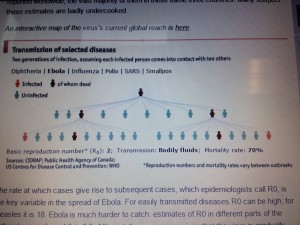EBOLA: A Susceptible Infectious Removed (SIR) model.
It has been reported by the World Health Organization (WHO) and by the affected countries that there have been approximately 5,504 Ebola related deaths and 14,413 cases reported. These figures may be an understatement seeing as to not all cases may have been reported.
To better understand the spread of the highly dangerous yet containable virus through three continents, I have modelled this spread with the aid of the Susceptible Infectious Removed model. This is a simple model that entails that if one is in a high risk area, they are represented as Susceptible in the model. If and when they contract the disease, they are Infectious. In the case they survive the epidemic, in the case of Ebola being below 30% chance of survival, they are Removed and are a block to the tree and network structure.
Despite the initial case remaining unknown, the model will help in understanding the spread and chances of further spreading of the disease. It will also help us answer an important question, “Faced with an epidemic, will it have a non-trivial chance of being perpetual?”
If we model the disease in a tree, each infected node k has a probability of passing the contagion to its children in next wave with probability p. If the value of p is large then there is a high chance of the spread of the disease and vice versa. It also holds that a large value of k would yield a high value for p, the probability of the disease being spread. This behavior is characterized by the product of the two values yielding R, the basic reproductive number of the disease. If it is below one, then the disease will die out in a finite number of steps in the tree but if it is above one it will persist indefinitely.
A great way of ensuring that the value of k is kept low in the case of Ebola as advised by the CDC is to avoid bodily contact with other people and primates and sanitize our hands regularly. This way the value of k is kept low and reduces the spread. In a comparative study of the three continents, all factors considered, Europe was the first to contain the disease which was contracted by only a single nurse in Spain. This was because the value k was kept at a value that was almost insignificant that the epidemic was dealt with as soon as it broke out. In the case of North America, USA being the affected country, the same case applied though less efficiently as there was some spread to the two nurses who took care of the initial patient, Thomas Eric Duncan.
In the case of the three most affected countries in Africa, Liberia, Sierra Leone and Guinea, the value of R can be said to have been above 1 if the resulting deaths are used as a measure of the exponential growth in the number of Ebola related deaths. This can be explained by the poor health services due to low number of doctors in the countries and lack of necessary equipment to take care of the quarantined.
Sources Cited:
http://en.wikipedia.org/wiki/Ebola_virus_epidemic_in_West_Africa
http://www.cdc.gov/vhf/ebola/outbreaks/2014-west-africa/qa.html
http://www.economist.com/blogs/graphicdetail/2014/11/ebola-graphics

